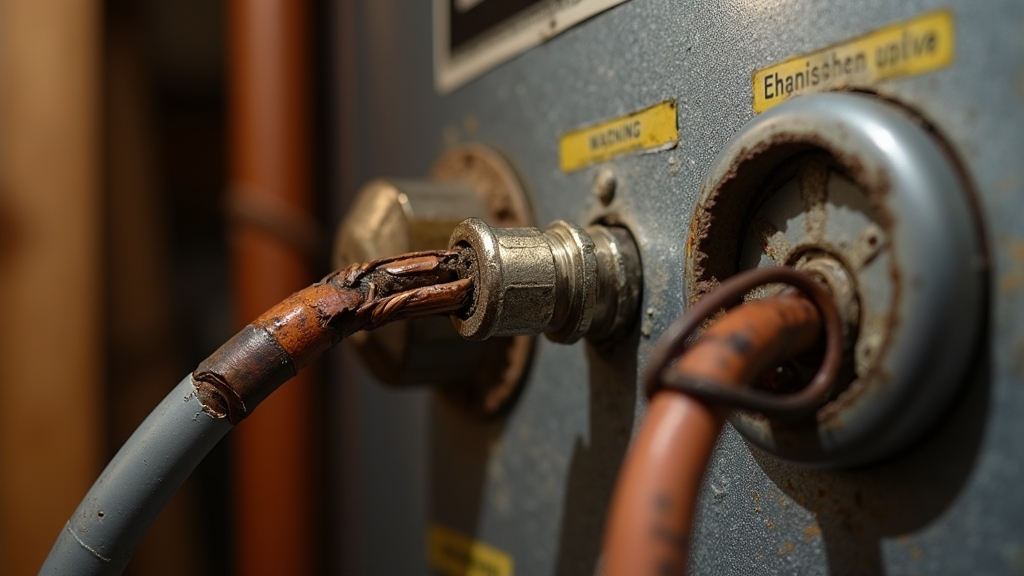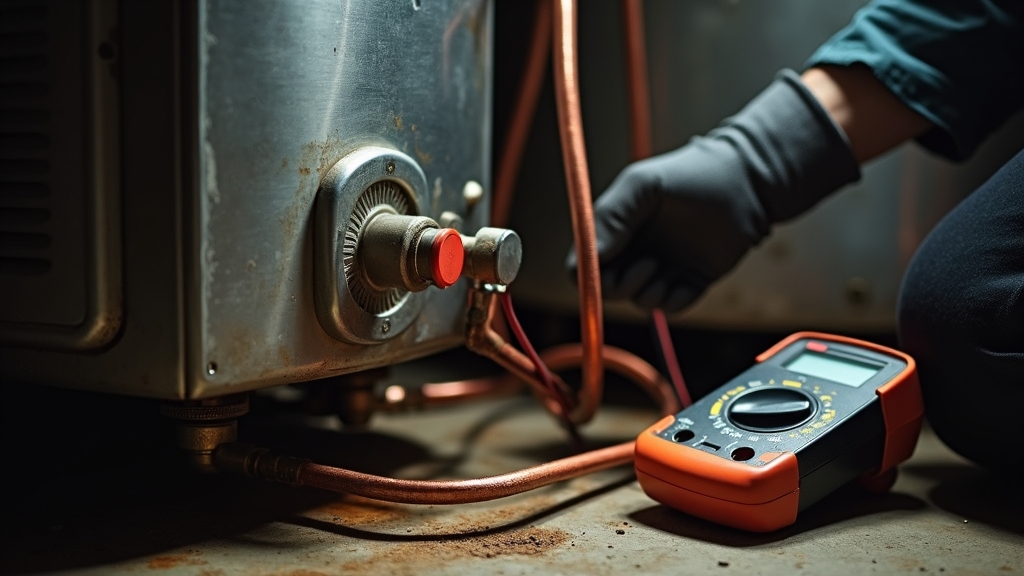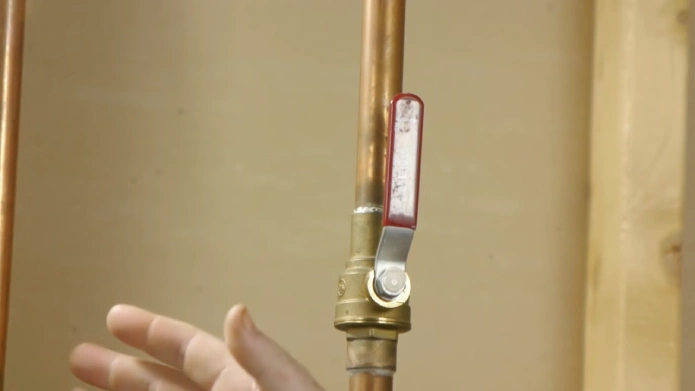You have to keep resetting your water heater because components like the thermostat, heating elements, or internal wiring are likely overheating or failing, which trips the safety reset to prevent damage. Mineral buildup, corrosion, or loose connections can cause this heat or electrical fault.
A malfunctioning reset button or high limit switch might also trigger false trips. Proper maintenance, sizing, and timely repairs reduce these issues. Understanding these causes helps you tackle the problem effectively.
Key Takeaways
- Burnt-out or shorted heating elements cause overheating, triggering the water heater’s reset button repeatedly.
- Faulty thermostats or high limit switches can cause false overheating signals, leading to frequent resets.
- Loose or damaged wiring creates electrical shorts or intermittent power, causing safety trips and reset button activation.
- Sediment buildup and corrosion inside the tank reduce efficiency and cause internal overheating, prompting resets.
- Undersized water heaters or improper maintenance increase reset occurrences due to frequent overheating and strain.
Common Causes of Water Heater Reset Button Tripping
Several common issues can cause your water heater’s reset button to trip, signaling a safety cutoff. A burnt-out heating element, often from mineral buildup or electrical faults, may overheat water and trigger the reset. You might notice a burning smell or metallic taste if this happens.
A burnt-out heating element, often from mineral buildup, can overheat water and trip your water heater’s reset button.
Loose or damaged electrical connections can generate heat or shorts, causing intermittent trips; these require professional tightening and inspection. It is important to disconnect power supply before attempting any inspection or repair.
The reset button itself or the high limit switch can malfunction, falsely sensing overheating and cutting power prematurely. The reset button, also called the emergency cut-off (ECO) switch, is designed to disconnect power if internal temperatures exceed 180°F, protecting your water heater from damage.
Internal overheating due to thermostat or element failures, or scale buildup insulating elements, also trips the reset. Finally, faulty circuit breakers or wiring issues that cause unsafe electrical conditions will activate the safety cutoff.
How a Faulty Thermostat Affects Your Water Heater?
If your water heater’s reset button keeps tripping, the thermostat may be the underlying issue. A faulty thermostat disrupts temperature regulation, causing overheating that triggers the high-limit switch, forcing resets to prevent damage.
Frequent popping out of the reset button is a clear sign of thermostat issues. It is important to ensure your water heater is installed in an appropriate location similar to how pump installation places affect their operation. It can also cause inconsistent water temperatures or insufficient hot water, indicating calibration or failure.
Key effects of a faulty thermostat include:
- Overheating water, increasing scald risk and tripping safety cutoffs.
- Fluctuating water temperatures due to improper temperature control.
- Slow hot water recovery as heating elements cycle inefficiently.
- No or insufficient hot water when the upper thermostat malfunctions.
Diagnosing involves testing electrical continuity and resistance to pinpoint the faulty thermostat, allowing precise repair without unnecessary replacements.
The Impact of Loose or Damaged Wiring Connections

How do loose or damaged wiring connections affect your water heater’s performance and safety? Loose wiring causes intermittent power loss, forcing you to reset your water heater repeatedly.
Loose wiring leads to power interruptions, causing frequent water heater resets and unreliable performance.
Poor connections generate arcing and heat, damaging components and insulation, increasing fire risk. Frayed or corroded wires disrupt current flow, causing operational failures and tripping breakers to prevent overloads or shorts.
These faults can trigger safety controls like the high-limit switch or T&P valve unnecessarily, compromising reliability. Diagnosing wiring issues is challenging because intermittent faults mimic thermostat or element problems and mightn’t trip breakers.
To maintain stable operation, ensure all wiring connections are secure, corrosion-free, and matched to correct wire gauge and breaker ratings.
Always consult a licensed electrician for repairs to prevent hazards and avoid further resets or damage.
Additionally, understanding the minimum runtime of your water heater pump system can help in diagnosing electrical issues related to frequent resets.
Identifying Corroded or Damaged Internal Components
Loose or damaged wiring isn’t the only issue that can disrupt your water heater’s operation. Internal component corrosion also plays a significant role. Corrosion inside the tank weakens its structure and reduces heating efficiency, often causing frequent resets.
To identify corrosion or damage, watch for these signs:
- Rusty or discolored water with a reddish-brown hue indicating internal rust.
- Small leaks or water pooling at the tank base from pinholes or cracks.
- Noticeable drops in water temperature or longer heating times due to compromised components.
- Changes in hot water pressure caused by sediment buildup restricting flow. Using a water leak alarm can help detect early leaks before extensive damage occurs.
Regularly inspecting for these indicators and flushing sediment can prevent further damage and improve reliability, reducing the need for constant resets. Additionally, replacing the anode rod proactively helps prevent corrosion and extends your water heater’s lifespan by maintaining its internal protective barrier anode rod replacement.
Signs of a Burnt-Out or Shorted Heating Element

What happens when your water heater’s heating element burns out or shorts? You’ll notice lukewarm water or insufficient hot water because one or both elements fail to heat properly.
If the lower element fails, only half the tank heats, causing hot water to run out quickly. Longer heating times and warm water at taps also signal element issues. A malfunctioning thermostat can exacerbate these problems by causing temperature inconsistencies.
Frequent circuit breaker trips or burning smells indicate electrical faults or overheating. These symptoms can often mean that the heating element is overheating or short-circuiting, which may cause the circuit breaker to trip frequently.
Physically, inspect for cracks, burns, corrosion, or loose connections on the element. Rusty water and strange noises may accompany failure. Use a multimeter to test element continuity and check water temperature at various outlets.
When the Reset Button or High Limit Switch Malfunctions?
After identifying issues with heating elements, you should also check the reset button or high limit switch, which plays a critical safety role in your water heater. It trips when water temperature exceeds about 180°F, cutting power to prevent overheating or electrical faults.
If it malfunctions or trips repeatedly, it signals an underlying problem. Common causes include faulty thermostats or worn reset buttons that fail to cut power, loose or corroded wiring causing heat buildup and false trips, shorted heating elements driving continuous overheating, or excess heat near the reset switch housing due to poor ventilation.
A faulty thermostat can become stuck, causing the heating element to keep running and trip the reset button due to overheating. Understanding the role of a high limit switch is essential for diagnosing such issues.
Diagnosing these faults requires caution because of high voltage and is best handled by professionals. Regular inspection and timely replacement of the upper thermostat assembly can prevent persistent reset button malfunctions.
How Water Heater Size and Capacity Influence Performance?
Because water heater size directly affects hot water availability and energy efficiency, selecting the right capacity is essential for ideal performance. If your heater is undersized, it won’t meet peak household demand, causing hot water depletion and possible resets.
Choosing the right water heater size ensures consistent hot water and prevents energy waste or system resets.
Oversized units waste energy through standby heat loss without improving comfort. For tank models, consider the First-Hour Rating (FHR), balancing tank volume and recovery rate to match household size and fixture flow rates. Proper water pressure also plays a role in system performance and should be maintained within an optimal range.
Tankless heaters require sizing based on combined fixture flow rates and temperature rise, with cold climates needing higher capacity. Proper sizing also supports lower operating costs and consistent hot water supply by minimizing energy waste and reducing wear on the system lower operating costs.
Accurately sizing your water heater guarantees continuous hot water during simultaneous use and avoids energy waste, preventing performance issues that might force frequent resets or reduce system reliability. Adjusting the water pressure regulator can help ensure consistent water flow and pressure, which contributes to the overall efficiency of your water heating system.
Preventative Maintenance Tips to Avoid Frequent Resets
You should establish a regular inspection schedule to catch faulty thermostats, wiring issues, and worn heating elements before they cause frequent resets. Regular checks help detect corroded components early, preventing unexpected system failures.
Always rely on licensed professionals for component servicing to guarantee accurate diagnosis and safe repairs. Consistent maintenance reduces the risk of overheating and protects your water heater’s longevity. Additionally, monitoring your system for pressure build-up can prevent potential damage and operational issues.
Regular Inspection Schedule
While frequent resets can signal underlying issues, maintaining a regular inspection schedule helps you identify problems before they escalate. To keep your water heater running efficiently and avoid constant resetting, you should:
- Schedule an annual professional inspection, focusing on the anode rod, pressure relief valve, burner, thermostat, and venting system. Proper installation and inspection can significantly influence the lifespan of components.
- Conduct monthly visual checks for leaks, corrosion, and listen for unusual noises indicating sediment buildup.
- Flush a small amount of water monthly from the drain valve to detect and reduce sediment accumulation.
- Perform a complete tank drain and flush at least once per year, or twice in hard water areas, to prevent overheating and component failure. Regular maintenance also improves energy efficiency, helping reduce your utility bills.
This consistent inspection routine ensures early detection of issues, prolonging your water heater’s lifespan and maintaining excellent performance.
Professional Component Servicing
Maintaining a regular inspection schedule sets the foundation for preventing frequent water heater resets, but professional component servicing plays a key role in addressing underlying mechanical and electrical factors.
You should flush and clean the tank annually to remove sediment that causes overheating and triggers resets, increasing flush frequency in hard water areas. Flushing the tank regularly helps maintain water flow and prevent buildup that reduces efficiency.
Test the Temperature and Pressure Relief valve every six months to ensure it releases properly and doesn’t leak. Testing the pressure relief valve ensures proper pressure regulation and prevents dangerous pressure buildup.
Inspect the anode rod yearly and replace it if corroded to prevent tank damage. Test and calibrate thermostats with a multimeter, tighten electrical connections, and uphold safe temperature settings between 120–140°F.
For gas heaters, clean burner assemblies and ensure flue and vent systems are free of blockages or corrosion to maintain combustion efficiency and avoid pressure-related resets.
When to Call a Professional Plumber or Electrician?
If your water heater’s reset button trips frequently or you notice signs of damaged wiring, it’s time to call a professional plumber or electrician. They’ve the tools to diagnose component failures like faulty thermostats and ensure all repairs meet safety standards.
Regular inspection can also identify loose or damaged wiring that might cause overheating and reset tripping. Don’t risk electrical hazards. Let experts handle complex issues to keep your system and home safe. Professionals can also help you understand how to safely reset electrical devices without damaging the unit.
Identifying Electrical Hazards
Because electrical hazards in water heaters pose serious safety risks, you need to recognize clear warning signs early. Ignoring these can lead to severe injury or costly damage. Watch for these indicators:
- Frequent tripping of the circuit breaker linked to your water heater
- Burning smells or visible scorch marks near electrical wiring
- Water pooling around electrical connections or components
- Flickering pilot light or failure to ignite despite power supply
Additionally, an aging water heater with worn components can increase the likelihood of electrical hazards, so consider the unit’s age as part of your safety assessment. If you detect any of these, avoid DIY fixes. Shut off power and water supply immediately, then call a licensed electrician or plumber. Mishandling electrical repairs risks shock, fire, and code violations.
Professionals guarantee safe diagnosis and repairs, protecting both you and your water heater system. Regular inspections help catch hazards before they escalate.
Diagnosing Component Failures
Electrical hazards often signal deeper issues within your water heater’s components. If basic troubleshooting like resetting the breaker or checking voltage doesn’t restore hot water, it’s time to call a professional. Qualified electricians can safely perform detailed electrical testing beyond your tools, identifying faults in heating elements or thermostats.
For gas units, licensed technicians handle pilot light and burner problems, ensuring code compliance. Persistent leaks or issues from faulty valves and heating element gaskets require a plumber’s expertise to diagnose and repair. Regular maintenance, such as flushing the tank to prevent sediment buildup, can help avoid many common problems.
Complex repairs such as replacing heating elements or thermostats, especially in older units, demand professional skills to prevent further damage. Don’t risk injury or costly mistakes; when symptoms persist or electrical hazards arise, trust a pro to accurately diagnose and resolve component failures.
Ensuring Safety Compliance
When working with water heaters, you must adhere to strict safety codes and regulations to protect your home and health. Handling gas lines, electrical connections, or safety devices incorrectly can cause severe hazards. Ensuring proper clearance requirements is vital to prevent fire risks and allow safe maintenance access.
You should call a licensed plumber or electrician when:
- Obtaining permits and scheduling inspections for new installs or major repairs.
- Installing or testing gas lines, electrical wiring, and safety controls.
- Verifying proper ventilation to prevent carbon monoxide buildup.
- Adjusting temperature regulation settings and ensuring relief valves function correctly.
Professionals ensure compliance with the National Fuel Gas Code and local regulations, preventing dangerous failures. Avoid DIY work on critical components to maintain safety features and meet legal requirements.
Frequently Asked Questions
Can a Water Heater Reset Itself Without Any Electrical Issues?
No, your water heater can’t reset itself without electrical issues. The reset button is a manual safety feature designed to cut power if the water overheats. It won’t automatically re-engage because that could risk continuous overheating.
If you see what looks like self-resetting, it’s likely a faulty button or intermittent electrical problem. You’ll need to press the reset manually each time to safely restore function.
Does Water Quality Affect How Often My Water Heater Resets?
If you live in an area with hard water, you might notice your water heater resets more often due to mineral scale buildup. This scale insulates heating elements, causing them to overheat and trip the reset button frequently.
To reduce resets, you should regularly flush the tank and consider installing a water softener. Managing water quality prevents scale accumulation, protects components, and improves your heater’s efficiency and reliability over time.
Is It Normal for a Water Heater to Reset After Long Periods of Non-Use?
Yes, it’s normal for your water heater to reset after long periods of non-use. Safety mechanisms like the reset button may trip due to residual heat, electrical glitches, or thermostat stress from inactivity.
Just make sure to turn off the power before resetting.
However, if the reset button trips frequently or won’t stay engaged, you should have a professional inspect your heater to rule out faulty thermostats, wiring, or other issues.
Can Seasonal Temperature Changes Cause My Water Heater to Reset Frequently?
Yes, seasonal temperature changes can cause your water heater to reset frequently. Colder incoming water in winter can increase heating element activity by up to 30%, stressing thermostats and causing overheating.
This extra workload may trigger the reset switch to prevent damage. To avoid this, inspect and tighten electrical connections, test thermostats, and flush your tank before colder months.
Are There Smart Water Heaters That Notify Me Before a Reset Is Needed?
Yes, smart water heaters notify you before a reset is needed. They send maintenance alerts and error codes via mobile apps, helping you spot sensor failures or temperature issues early.
Some models integrate with voice assistants for hands-free updates.
These devices also monitor energy use and detect leaks, allowing you to address faults proactively. This prevents frequent resets, extends your heater’s lifespan, and improves safety and efficiency.
Fixing the Root Cause Instead of Just Resetting
If your water heater keeps tripping the reset button, imagine a circuit breaker flickering under strain—worn thermostats, loose wiring, or corroded parts disrupt the flow. Picture those hidden components silently wearing down, forcing frequent resets to protect your system.
Regular maintenance acts like a shield, keeping everything tight and functional. When problems persist, don’t hesitate to call a professional plumber or electrician to restore steady warmth and peace of mind.



